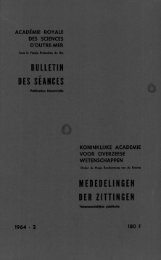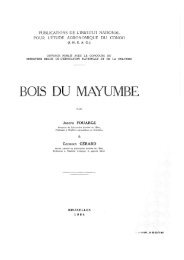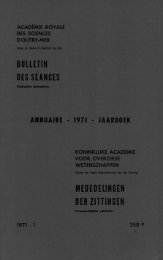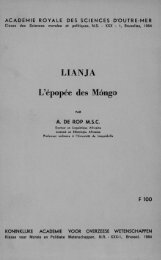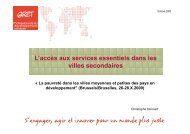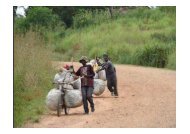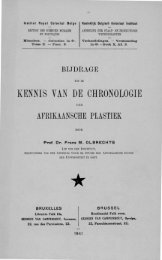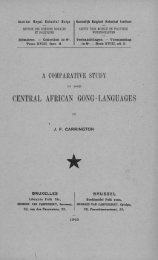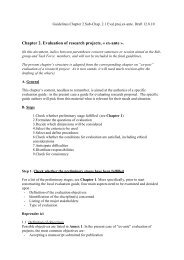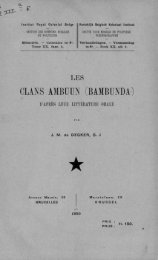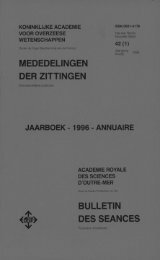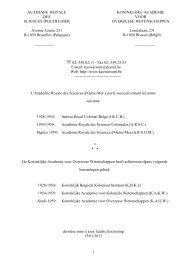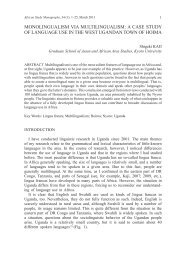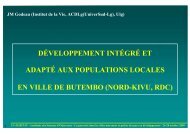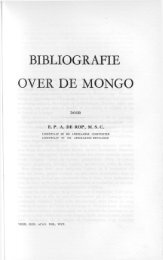KONINKLIJKE ACADEMIE VOOR OVERZEESE WETENSCHAPPEN ...
KONINKLIJKE ACADEMIE VOOR OVERZEESE WETENSCHAPPEN ...
KONINKLIJKE ACADEMIE VOOR OVERZEESE WETENSCHAPPEN ...
You also want an ePaper? Increase the reach of your titles
YUMPU automatically turns print PDFs into web optimized ePapers that Google loves.
Meded. Zitt. K. Acad. Overzeese Wet.<br />
Bull. Séanc. Acad. R. Sci. Outre-Mer<br />
52 (2006-3): 279-302<br />
Artificial Propagation and Culture of Climbing Perch<br />
(Anabas testudineus Bloch, 1792) in the Mekong Delta<br />
by<br />
Duong Nhut Long*, Lam My Lan*,<br />
Nguyen Anh T u a n * & Jean-Claude M ic h a **<br />
K e y w o r d s . — Artificial Propagation; Fingerlings’ Production; Feeding Rate; Survival<br />
Rate; Climbing Perch; Anabas testudineus.<br />
S u m m a r y . — Climbing perch is a new freshwater species for fish culture that has been<br />
developed recently in an intensive system. The results show that the brood stock of<br />
climbing perch reach maturation after 50-60 days and that artificial spawning can be<br />
easily stimulated by hormones’ injection (0.8 mg/kg of common carp’s pituitary gland,<br />
3,000 UI/kg of HCG and 50 |ig/kg of LH-RHa).<br />
As far as weight gain is concerned, the final body weight of climbing perch after<br />
six months is 66 g/fish at high starting density (50 fish/m2) but lower than 72 g/fish at<br />
weaker density (30 fish/m2). The total fish biomass obtained was 24,600 kg/ha at weaker<br />
density (30 fish/m2) compared to 21,300 kg/ha. However, the cost ratio benefit and cost<br />
ratio profit were lower (1.56 and 0.56) at weak starting density compared to a higher<br />
density ( 1.64 and 0.64).<br />
Therefore, the results provide precious information for fish farmers so that they can<br />
choose their culture strategy.<br />
M o t s - c l e s . — Reproduction artificielle; Production d’alevins; Taux d’alimentation;<br />
Taux de survie; Perche sauteuse; Anabas testudineus.<br />
R e s u m e . — Reproduction artificielle et élevage de la perche sauteuse (Anabas<br />
testudineus Bloch, 1792) dans le delta du Mékong. — La perche sauteuse est une nouvelle<br />
espèce pour la pisciculture d’eau douce dont l’élevage intensif se développe rapidement.<br />
Les résultats montrent que les géniteurs atteignent leur maturité après 50 à 60 jours et leur<br />
reproduction artificielle est facilement provoquée par injection d’hormones (0,8 mg/kg<br />
d’hypophyse de carpe commune, 3 000 Ul/kg de HCG et 50 mg/kg de LH-RHa).<br />
En ce qui concerne le grossissement, le poids moyen final après six mois est de 66 g à<br />
une densité de mise en charge fort élevée (50 poissons/m2) mais de 72 g à plus faible<br />
densité (30 poissons/m2). La biomasse finale récoltée a été de 24 600 kg/ha à plus faible<br />
densité (30 poissons/m2) comparée à 21 300 kg/ha à plus forte densité de mise en charge<br />
(50 poissons/m2). Toutefois, le rapport coût/bénéfice et le profit ont été plus faibles (1,56<br />
et 0,56) à faible densité de mise en charge par rapport à une densité plus élevée (1,64 et<br />
0,64).<br />
* College of Aquaculture and Fisheries Sciences - Can Tho University, Can Tho (Vietnam).<br />
** Membre de l’Académie; FUNDP, URBO, Nam ur (Belgium).



